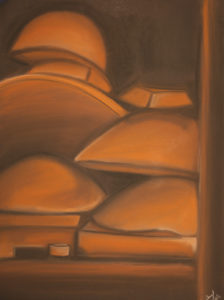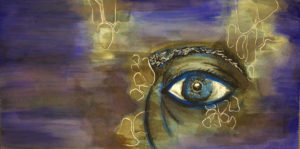
Gatsby Changes his Tune
By Lexus Waymire '15
LAS 410: The Great Gatsby
The cultural transformations assignment asks students to consider how other artists have transformed the Gatsby materials into another art form. How does a different genre necessarily distort the novel, and to what effect? Lexie presents us with an excellent study of how John Harbison’s opera transforms Fitzgerald’s novel into a different register with a new set of cultural meanings.
– Walter Cannon
The art of music has the ability to be beautiful, inspiring hope and happiness in its listeners. However, art that truly imitates life cannot be exclusively beautiful; viewing a work of art may be a challenging experience. A prime example of such art is John Harbison’s operatic adaptation of F. Scott Fitzgerald’s novel The Great Gatsby. As a “high-brow” art form, opera often conjures negative connotations. This, in combination with Harbison’s non-melodic, dissonant compositional style, makes the opera one of the lesser-known transformations of Gatsby. However, the success of Harbison’s opera is irrelevant to its importance and merit. Harbison expertly uses original songs and arias, vocal timbres of individual characters, and harmonic tension to bring Fitzgerald’s characters to life. His use of modern compositional techniques asks the audience not necessarily to enjoy, but to feel the tension that constantly lurks behind Fitzgerald’s characters, their longing to repeat the past, and their pursuit of the American dream.
Since the early 1900s, opera in the United States was often viewed as a form of “highbrow art” (Levine), its European roots suggesting that primarily the refined and intelligent of the upper class may attend. Today it carries a similar reputation, along with the stigma that opera is dull, incomprehensible, and old-fashioned. While it is true that opera takes a certain amount of education prior to appreciation, this is not to say that only the upper-class can appreciate and enjoy opera. While the twentieth-century techniques in Harbison’s The Great Gatsby may not be ideal for a first-time opera goer, its loyalty to Fitzgerald’s plot makes it easy to follow for readers of Fitzgerald’s novel.
When a classic novel is transformed into a film, play, or, in this case, opera, dedicated fans are often infuriated when the author’s original work is not followed to the letter. Rather than reimagining the figures in The Great Gatsby, Harbison uses several unique elements of opera to dig deeper into Fitzgerald’s characters. One element is the addition of the aria. An aria is typically used as a way for a character to express his or her inner thoughts or struggle. Because Fitzgerald uses Nick as a narrator, many of the feelings of the other characters are left to interpretation. Harbison chose to use his interpretations of these feelings and gives the audience a closer look into the minds of other characters. A good example is Myrtle’s second aria, “Waiting”, during which Myrtle Wilson waits for her lover, Tom, to return to the gas station where she lives with her husband. In Fitzgerald’s book, we only get to know Myrtle on a surface level. Here we see more deeply into her reasoning for her affair with Tom. Her life with gas station owner George Wilson is nothing like she expected, and she now longs to be with Tom, who treats her “like a queen” (Harbison 59). Another unique convention of opera is the use of a chorus. Harbison chose to give Gatsby’s party-goers a singular voice, using a chorus of singers to show how little Gatsby’s guests cared about their host. As the chorus sings at one of Gatsby’s grand occasions, they do not care “where the money comes from” just “as long as Gatsby’s lights are on” (Harbison 44). One of Fitzgerald’s themes is that all humans are flawed and selfish, and it is difficult for the reader to imagine such careless individuals. However, Harbison provides a unique alternative perspective by allowing us to see into the minds of each character, perhaps justifying, or at least explaining, the reckless actions that take place in Gatsby’s world.
Perhaps the most powerful aspect of music is its ability to influence human emotions and subconscious. Harbison harnesses that aspect and uses it to comment on the character traits of each of Fitzgerald’s characters, subtly swaying the listener’s opinion about each one of them. The clearest example is the musical portrayal of Tom Buchanan. In Act I, Scene I, Daisy, Jordan, and Nick sit and chat like old friends. When Tom bursts onto the scene, the orchestra is abruptly silent, then accompanies Tom’s harsh words with dissonant and staccato strokes from the string section. Tom’s vocal lines are also written in a brash, non-lyrical style, reflecting Daisy’s description of her husband: “hulking”. From the very beginning, the audience is swayed by the orchestral and vocal color to consider Tom a villain.

Unusual Point-of-View by Cheryl Wells
Harbison also excels at choosing specific voice parts and timbres for specific characters. For example, Jordan and Myrtle, the two most ethically questionable female roles, call for mezzo-sopranos. The lower, more ominous tone of a mezzo is used in this work to evoke feelings of trouble or distrust from the audience. Gatsby is cast as a high, lyric tenor, asking the audience to sympathize with him and his selfless love for Daisy. Another fine example of the use of musical line in character portrayal is Harbison’s compositional style for Daisy. The audience senses Daisy’s trouble soul through her dramatic change in vocal timbre. When Daisy is in a social setting, she puts on a mask portraying the “perfect little fool” she wants her daughter to grow up to be. Her voice is high and wistful, hardly landing on a note before whisking to another. However, when Daisy becomes insightful or angry, she reverts to her deeper, earthier timbre. This is Harbison’s way of showing how Daisy can manipulate her feelings, and the feelings of others, by putting on a show. Harbison’s portrayal of Daisy is different from many other transformations of Fitzgerald’s novel, as the audience gains more explicit insight into her thought process. By the end of Act I, Scene III, we see Daisy reflect on how she has sacrificed simple happiness to fit into the American Dream mold by marrying Tom and acting the part of wife and mother. In two of her somber arias, she seeks “the old warm world” (Harbison 12), fearing that her youthful happiness is “gone forever” (Harbison 12). The only dissatisfying vocal choice is that of Nick Carroway as a bass. Nick is often portrayed in the book as unsure and unstable, and the bass tone is far too rooted for Nick’s character.
In addition to vocal interpretation, Harbison seems to have a different idea of Nick, and consequently Gatsby, and their roles in the story. Nick is “transferred from narrator to supporting player,” and now serves more as an observer and occasional commentator” (Woolfe). Perhaps his deeper voice was meant to make the audience feel they could trust his opinion, but in many performances it seems that Nick is just out of place. With no narrator, “Gatsby is forced to explain himself and the import of his story in excessively literal arias” (Woolfe), taking some of the mystery out of our title character. In addition to his lyrical tenor voice, Gatsby’s overall character development and portrayal asks us to view him as a tragic figure. We admire him for fully committing to his dream, but pity him as we watch him fall short of his dream. Jordan comments in the final scene at Gatsby’s funeral, “He got what he deserved— he came too far, he built too high (Harbison 65). We root for Gatsby throughout the show, but know that the world does not always work in favor of the deserving. Gatsby dedicated his entire life to winning Daisy, but Fitzgerald’s plot tells us that fate is uncontrollable. Perhaps Gatsby’s character is Harbison’s way of conveying the fragility and ultimate hopelessness of chasing the American Dream.
In addition to the colorful cast of characters, The Great Gatsby is recognizable for its 1920s setting. Harbison once again uses music to seamlessly connect modern opera to 1920s jazz. Harbison added newly composed jazz pieces to be sung by a bandstand singer at Gatsby’s parties, as well as on the radio. The pieces were so authentic that listeners believed them to be original to the period. Act II, Scene I is the most intriguing example of a weaving together of jazz and modern opera. Daisy and Tom exchange in a heated conversation in a non-melodic operatic style, which transitions into a jazz solo by the bandstand singer. After the solo, Harbison combines the two styles, with the singers continuing in the angular style of modern opera, while the orchestra accompanies with the melody from the bandstand singer. Harbison’s ability to go beyond the 1920s costuming and scenery, once again using music to take the minds of the audience to another place, time, and mindset.
If the music was so masterfully composed, one may wonder how this opera received such mixed, and often negative, reviews. A review by Zachary Woolfe in The New York Times claims that Harbison’s opera lacks energy, heart, and the ability to carry itself without the use of the “pseudo-1920s pop songs” (Woolfe). All music not stemming from 1920s jazz is reviewed as something incomprehensible, and there are not many critics who enjoy Harbison’s use of modernism.
When all is said and done, what is Harbison trying to say? He seems to return again and again to the same themes: the allusion of a dream and the elusiveness of the past. As mentioned, Daisy frequently sings of her search for “the old warm world.” Throughout the course of the show, we watch as she realizes that perhaps the life she has is not the life she truly wants, but it may be too late for her to recover the past. Gatsby, also obsessed with reclaiming the past, comes into her life and shows her a glimmer of what could have been. Harbison clings to Fitzgerald’s line “repeat the past,” letting the characters at Gatsby’s party exchange the motive repeatedly. Both Daisy and Gatsby long to have what they once had, while Nick insists that “you can’t repeat the past.” Harbison melds the ideas of the American dream and the unattainable past at Gatsby’s funeral, where Nick sings, “his dream must have seemed so close. He did not know it was already behind him” (Harbison). Harbison reached into the many themes in Fitzgerald’s novel and pulled out the hopelessness of past dreams, using musical motives and repetition to make this idea the core of his opera.

“Blue” by Ashton Mayer
While this opera celebrated some limited success, it seems that most critics and listeners have little use for it. One reason could be Harbison’s seemingly random use of dissonance and angular rhythm. It is almost as if Harbison is trying to make the listeners uncomfortable by using harmonic tension that goes unresolved, representing the turmoil underneath the surface of the seemingly perfect lives of the upper class. At times, this opera is truly a challenge to absorb, but it is a work of art that does not have to be beautiful to make a statement. It is unfortunate that opera is largely associated with the upper class, as the unique musical emotion Harbison presents to his audience cannot be experienced in any other art form. This transformation of The Great Gatsby, through the many faces of musical composition, truly takes on a life of its own.
Works Cited
Harbison, John, and F. Scott Fitzgerald. The Great Gatsby: Opera in Two Acts. New York: G. Schirmer: 1999. Print.
Levine, Lawrence W. Highbrow/lowbrow: The Emergence of Cultural Hierarchy in America. Cambridge, Mass.: Harvard UP, 1988. 144-146. Print.
Woolfe, Zachary. “The Rich Are Different: They Can Sing.” The New York Times. The New York Times, 14 July 2013. Web. 24 Nov. 2014.